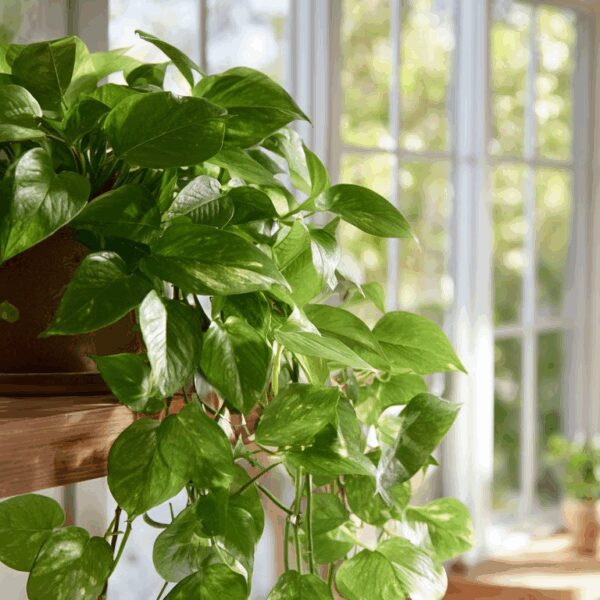As the vibrant hues of fall start to paint our landscapes, it’s time to turn our attention to Fall Plant Care for our beloved houseplants. Just like us, they need a bit more TLC as the days grow shorter and that warm sunlight becomes a rare treat. So, if you’ve noticed your greenery stretching towards the light like they’re reaching for a cozy blanket, it might be time to reassess their setup and give them the seasonal love they crave!
🌱 Green Thumb Essentials in 4 Points:
- Light is Key! ☀️ As summer fades, your plants might feel a bit neglected in the light department. Move those beauties like pothos and snake plants closer to sunny spots. If they’re stretching for the window, they’re sending you a SOS for more sun! And if the natural light is just too low? Grab some grow lights. They work wonders!
- Water Wisely! 🚰 With shorter days, your plants need less water. Overwatering can lead to root rot—yikes! Always check that top inch of soil; if it’s dry, give them a drink. If it’s still moist, wait a bit longer. This goes for your favorites like peace lilies and spider plants. And don’t forget about those needy succulents—less is definitely more!
- Nourish Smartly! 🥦 It’s not just about feeding; it’s about feeding right! Switch to a low-nitrogen fertilizer during fall to keep your houseplants happy without pushing them into overdrive growth. Remember, too much fertilizer can lead to salt buildup—let’s keep those roots healthy, not crispy!
- Pest Patrol! 🐛 As the season changes, bugs might want to crash your plant party. Keep an eye out for spider mites and aphids lurking on new growth. A soapy water wipe-down can help keep them at bay. And if things get serious? Neem oil is your best friend—just follow the instructions carefully!
So there you have it! With these tips, you’ll be well on your way to keeping your houseplants happy and thriving all through fall. 🍂🌿
Keep Your Houseplants Happy as Days Get Shorter
As fall rolls in and those lovely, long summer days start to fade, your houseplants will need a little extra love to thrive. The shorter days can trigger changes in their growth patterns. Light becomes a big deal. Plants like pothos and snake plants might seem okay with lower light, but they’ll still appreciate any sunny spot you can provide. If you notice their leaves stretching toward the window, that’s a telltale sign they’re craving more sunlight.
Consider moving them closer to south-facing windows if possible. And if natural light is really lacking, don’t shy away from grow lights. These can be a game-changer for keeping your green friends happy and healthy through the darker months.
Watering: Less is More
With lower light levels, plants tend to use less water. So, this is the time to adjust your watering routine. Overwatering can lead to root rot—definitely not something you want! Always check the top inch of soil before giving them a drink. If it’s dry, it’s time to water; if it’s still moist, hold off for a few more days. This applies to your favorites like peace lilies and spider plants as well.
The #1 Reason Your Houseplants Keep Dying (It’s Not What You Think)
And remember, plants like succulents or cacti will need even less water during fall. They’re naturally adapted to survive on minimal moisture, so keep that watering can at bay!
Nutrients: Feed Wisely
Fall isn’t typically when you’d think about feeding your houseplants, but a bit of care can make all the difference. If you’ve been using a balanced fertilizer throughout summer, now’s the time to switch gears. Look for a low-nitrogen fertilizer or one specifically designed for houseplants in dormancy mode—like Miracle-Gro’s Indoor Plant Food. This helps keep them nourished without encouraging too much new growth that could struggle under low light conditions.
But be cautious! Too much fertilizer can lead to salt buildup in the soil, which is harmful. You want happy roots, not crispy ones!
Pest Patrol: Stay Vigilant
The change in season can also stir up pests looking for a warm place to settle in. Keep an eye out for common intruders like spider mites and aphids—especially on tender new growth. A quick wipe-down of leaves with soapy water can deter these pesky visitors. If you notice webs or sticky residue on your plants, act fast! Neem oil is an effective organic option for treating infestations; just apply it according to package instructions.
If you have multiple plants and spot pests on one, it might be wise to isolate the affected plant until you’re sure the issue is resolved.
Humidity Matters: Embrace Fall’s Dry Air
You might even want to mist them lightly every now and then during dry spells—but don’t overdo it! A light touch goes a long way.
Time for Repotting? Check Those Roots!
If you’ve got houseplants that seem root-bound or are outgrowing their pots—like rubber trees or fiddle leaf figs—fall might actually be a great time for repotting. Just make sure you’re using fresh potting soil; this helps replenish nutrients depleted over time and improves drainage.
When repotting, gently loosen the roots but avoid tearing them apart too aggressively. You want them healthy and ready to adapt to their new home!
So as we enjoy those crisp autumn days ahead, remember these tips to keep your houseplants thriving through the seasonal shift. They depend on your care—and trust me—it’ll be worth it when those beautiful leaves start shining again come spring!







